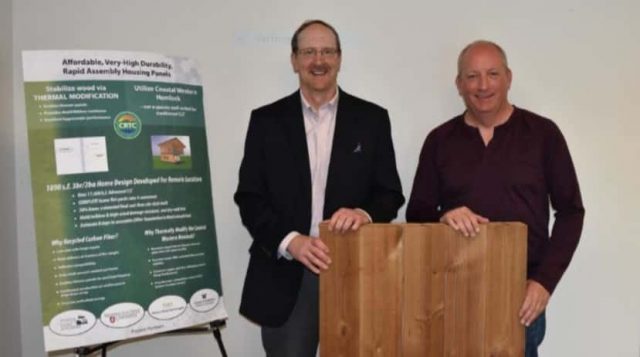
PORT ANGELES – The Composite Recycling Technology Center (CRTC) in Port Angeles is once again breaking ground with cutting edge technology, and they’ve pledged to use their latest product to benefit local homeless veterans.
CRTC has entered into an agreement with Pennies For Quarters to construct 24 tiny homes utilizing their Advanced Cross Laminated Timber (ACLT) System.
CEO David Walter and Pennies For Quarters founder Matt Rainwater stopped by the Todd Ortloff Show to announce the new partnership. Walter described for us the concept.
“The idea here is this is what we call our Advanced CLT, what we’re able to take coastal western hemlock, and it’s not typically used a lot in building materials. It’s a beautiful tree but it grows really fast and so it’s not super strong and so it gets used in kind of less value applications. We said, okay, how could we better utilize that that species? And we take it through what’s called a thermal modification process where you basically take it up to 400 degrees Fahrenheit, but without oxygen, so it doesn’t burn. Its in the presence of nitrogen, and it really densifies the wood. It burns off the sugars in the lignin. So now it’s not attractive to termites and it’s a lot more rot-resistant. The challenge then is it’s not as strong as it should be and that’s where the carbon fiber comes in. And so we insert carbon fiber into those panels as a part of the CLT and now we have a super strong, super stiff wall panel that goes up really quick.”
The patent pending Advanced CLT system provides for very fast construction as each tiny home can be built in less than 3 days once the foundation is in place. The tiny homes will be highly energy efficient with R-32 in the walls and R-40 in the ceiling.
The 24 homes, ranging in size from 240 to 400 square feet, will be constructed on the 7-acre Devanny Lane parcel that Pennies For Quarters owns near Fairchild Airport.
Rainwater is currently working on fundraising to pay for the homes, site development, and outreach to the area’s neighbors to reassure them about the project.
“When people hear about homeless people are moving in next door, they’re going to be afraid “tent city” or something along those lines, and that’s not what this is going to be at all. You know, as we move forward with CRTC and start building the tiny homes, the look on this is just amazing. The interiors here, you’re not going to have to have drywall, we’re not going to have to have two by fours. The walls are going to go up, the interior going to be wood and this stuff is incredibly sturdy. And that’s one of the things that we were looking at. This will help us on maintenance costs. The stuff is going to be around a long time. These are going to be tiny houses that are actually livable, because the people that are going to be the clients there are going to be living there for up to two years while they get their lives back on track. And it’s going to be a really nice situation. It’s going to be 240 square feet for a veteran and a significant other, 400 square feet for a tiny house for a family of four. So there’s gonna be a mix and match of that going on on the property.”
Walter says the benefits of producing the company’s new building materials will reach well beyond this one project.
“So it’s not only a sustainability mission, but we’re creating jobs at the same time because it’s going to take people to be able to put these together. Whether you’re on the construction side or whether you’re on the carbon fiber side or whether you’re on the thermal modification side. But I mean we envision seeing a small thermal modification facility here that can make this wood. That can be basically take the timber from the coast, thermally modify it, it can be used for siding, flooring, decking, it replaces pressure treated lumber, and it can also go into a cross laminated timber. So it’s a really good application.”
Rainwater says he hopes to have his first model home to show off sometime in the near future.
“We’re hoping to have a model tiny home built soon after we secure the funding and we’ll have it stored someplace so that people can go by take a look at it. And we get that question a lot. “Do you have a model?” You know, everybody’s seeing the tiny house on the trailer that we have, like, “is this what it’s going to look like?” And my answer is no, that’s really just our traveling billboard, so people know what we’re doing. But now they’re going to have some place to where potential donors or investors, we can set up a meeting time and place and let them look at it.”
Those interested in making a donation to the project to help homeless veterans can do so at the Pennies For Quarters website at penniesforquarters.org/donate/
Photo: Dave Walter, CEO of the CRTC and Matthew Rainwater, Founder and President of Pennies For Quarters, stand in front of an advanced CLT panel at the CRTC’s headquarters in Port Angeles.
